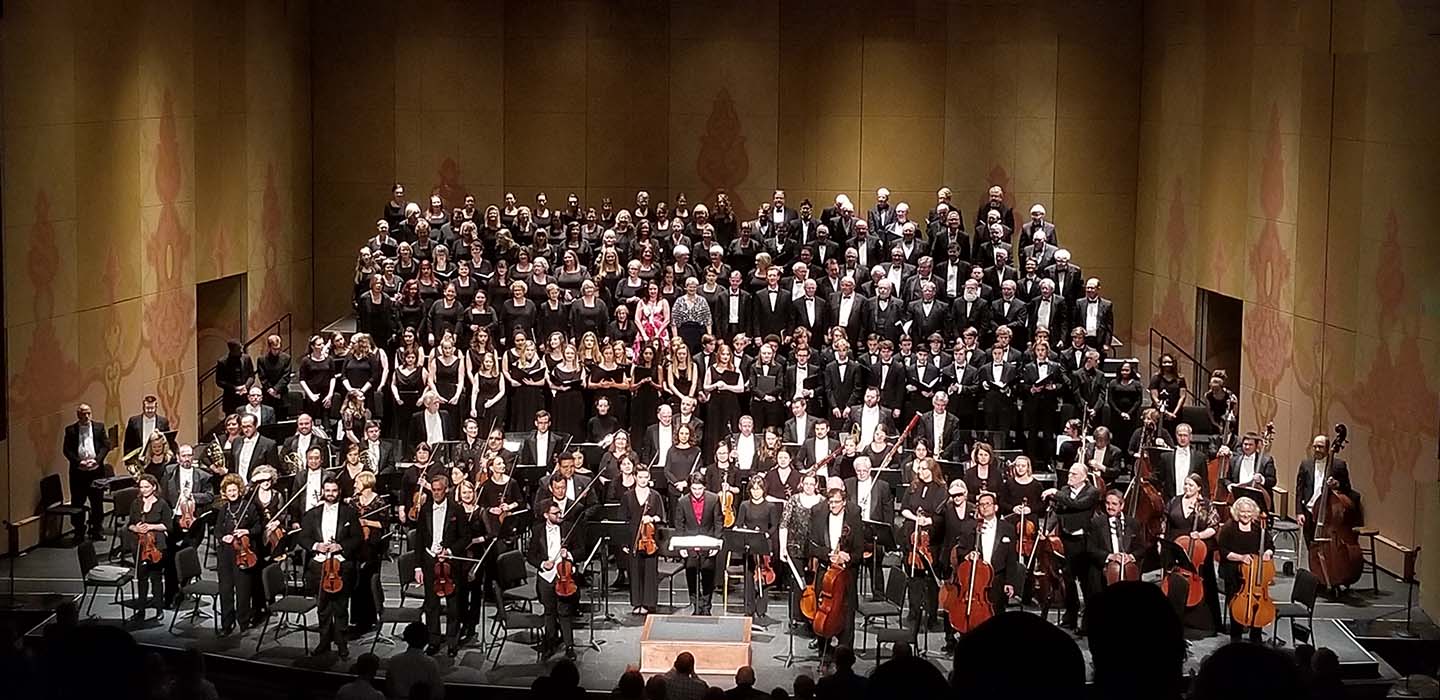If works of music were living human beings, they would no doubt be nervous, if not outright frightened, to be paired on a concert with Beethoven’s Ninth Symphony. Yet, the pairing of contemporary works with Beethoven’s brilliantly majestic and epic final symphony has become a fairly common occurrence for 21st Century orchestras, and for probably sound programming reasons. That was the wildly successful approach taken by the Knoxville Symphony Orchestra’s music director Aram Demirjian in this weekend’s Masterworks concerts in which the evening’s works were stylistic opposites by their sonic appearances, but were bound together by a philosophical theme, one that is inarguably relevant to the contemporary world.

To that end, Demirjian prefaced the concert with remarks aimed at addressing the anthemic relationship of the opening work, Banner, and the concert-closing Beethoven Ninth. Banner, a work by the contemporary American composer, Jessie Montgomery, was commissioned by the Sphinx Organization as a tribute to the 200th anniversary of the “Star Spangled Banner” and is described by the composer as being “…an ideal subject for exploration in contradictions. For most Americans the song represents a paradigm of liberty and solidarity against fierce odds, and for others it implies a contradiction between the ideals of freedom and the realities of injustice and oppression.”
With Banner scored for a string quartet joining a string orchestra, Montgomery’s work proved to be an ear-delighting feast of rhythmic energy and textural diversity for the KSO players. Percussion effects from strings are thrown about the ensemble, as are the Charles Ives-ish lyrical evocations of a number of tunes, including the “Star Spangled Banner” itself—although dissolved in a savory dissonance of suggested folk melodies. The journeys from lyricism to dissonance felt strangely liberating in the hands of the string quartet—concertmaster William Shaub and Gordon Tsai, violins; Kathryn Gawne, viola; and Andy Bryenton, cello. Principal bass player Steve Benne also had a solo passage that made quite a tactile statement of attitude.
Following Banner, and completing the first half, came Time, Like An Ever Flowing Stream by W. Mark Harrell, a former member of the KSO horn section. The work was commissioned by the KSO and given its premiere in 2009. Not surprising, Harrell integrated a love for his instrument into the lovely opening horn passage, played luminously here by KSO principal horn Jeffery Whaley and backed up by the KSO horn section, who were, incidentally, noteworthy throughout the evening.
Before beginning Beethoven’s Ninth Symphony on the second half of the concert, Demirjian again took the opportunity to lay some philosophical groundwork on his theme for the evening, reminding the audience that everyone takes in the work on a individual level—good, bad, or indifferent—and what we do with it makes all the difference. On one hand, Leonard Bernstein, on the occasion of the fall of the Berlin Wall in 1989, altered the text of “Ode to Joy” to become “Ode to Freedom.” And, the European Union uses the choral theme as its generic anthem. On the unfortunate other hand, the Ninth was regularly performed by the Third Reich and was used to recruit students to Emperor Hirohito’s army in 1944.
Admittedly, the choral fourth movement (Presto) gets the bulk of popular attention due to the majesty of the text and the forces generally thrown at it: soprano, alto, tenor, and bass soloists and a choir large enough to fill whatever space is available. Despite the scale of the fourth, the first three movements are themselves masterpieces of construction that show Beethoven at his symphonic pinnacle. The constant delight of orchestral colors achieved by interplaying woodwind motifs against string rhythms is distinctively Beethoven, one that allows him solidity and volume one moment, and colorful subtleties the next.
On this occasion of the Ninth, the KSO gave the audience what they came for—a feast of emotions and well-played performances across the orchestra. Demirjian built the excitement gradually on Friday evening, extracting warmth and dramatic details in the first two movements with a careful ear for expressive dynamics. The third movement, Adagio, was simply sublime in the emerging details and vibrant personality, and in some impressive individual performances, including a lovely fourth horn solo from Kelsey Bentley.
The fourth movement, the choral finale based on Friedrich Schiller’s “Ode to Joy”, always seems to take one by surprise. Demirjian’s tempos took on an added urgency that, of course, turn to a frenetic joy at the conclusion. The quartet of soloists, placed in the middle of chorus risers for the sake of inclusion and balance inside the orchestra shell, was excellent: soprano Kathryn Frady, mezzo-soprano Jan Wilson, tenor Andrew Skoog, and bass Griffen Tracy. Their vocal projection worked surprisingly well on a stage literally packed with orchestra and chorus.
Excellent, too, was the chorus made up of members of the Knoxville Choral Society (John Orr, director) and the Webb School of Knoxville Chamber Singers (LeAnne Johnson, director). An interesting addition came from eight members of the Tennessee School for the Deaf who signed the “Ode to Joy” text—a connection to the fact that Beethoven himself had become completely deaf by the time of the first performance of his Ninth Symphony in 1824.








